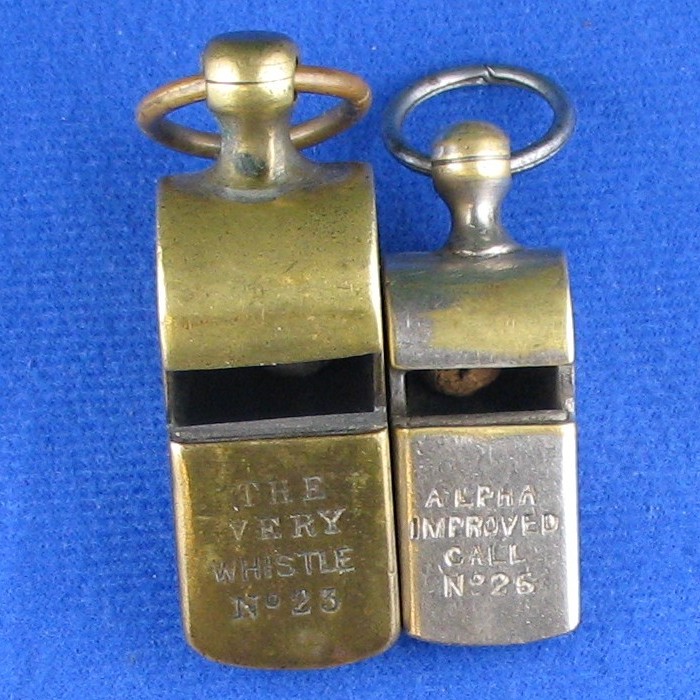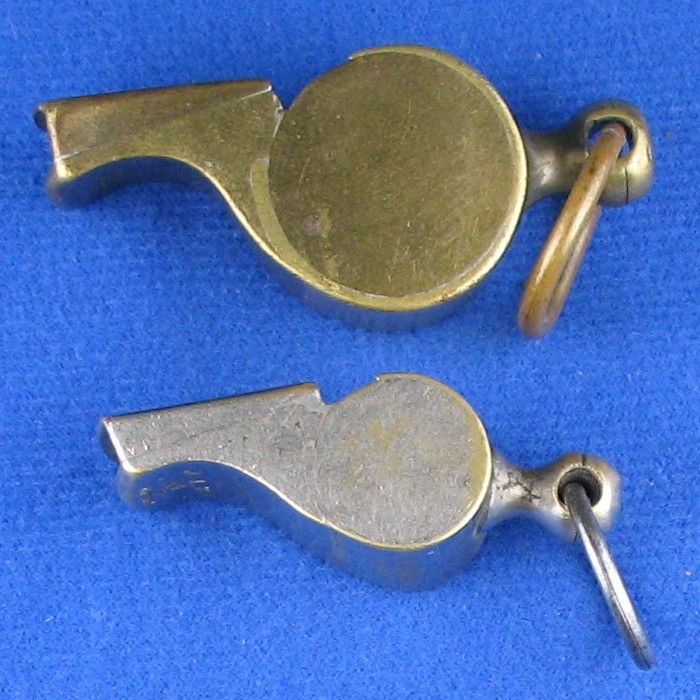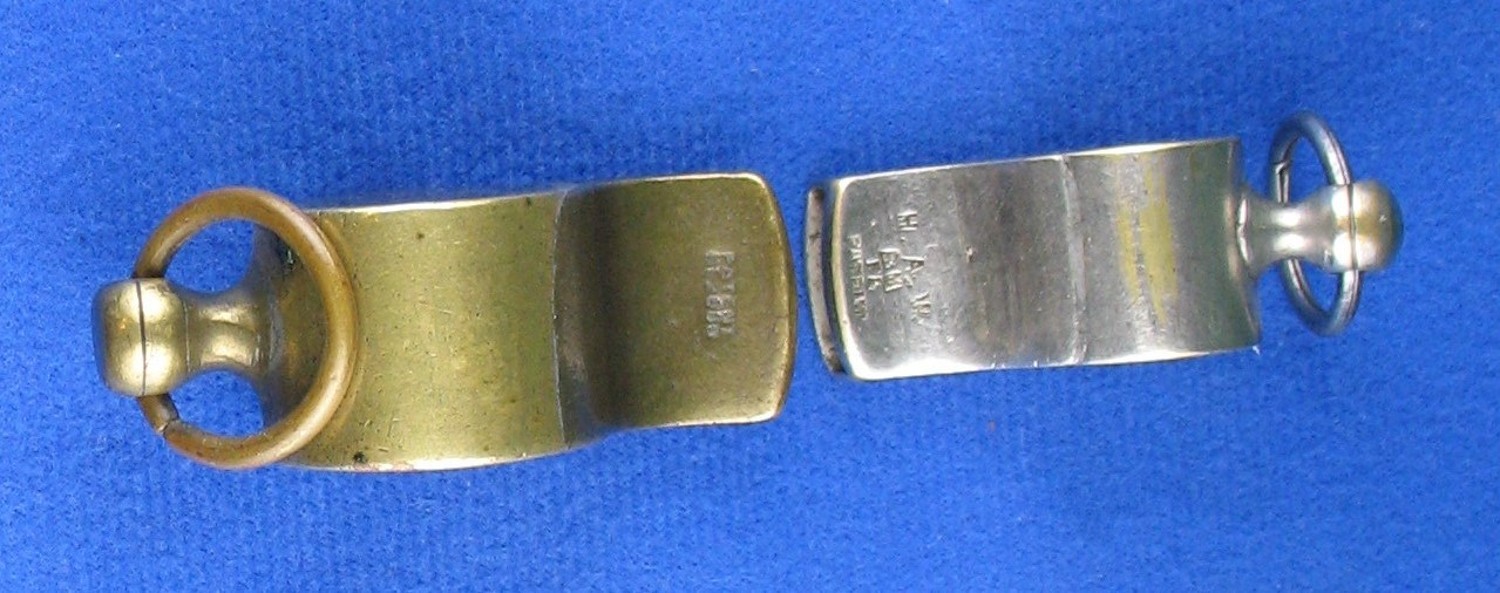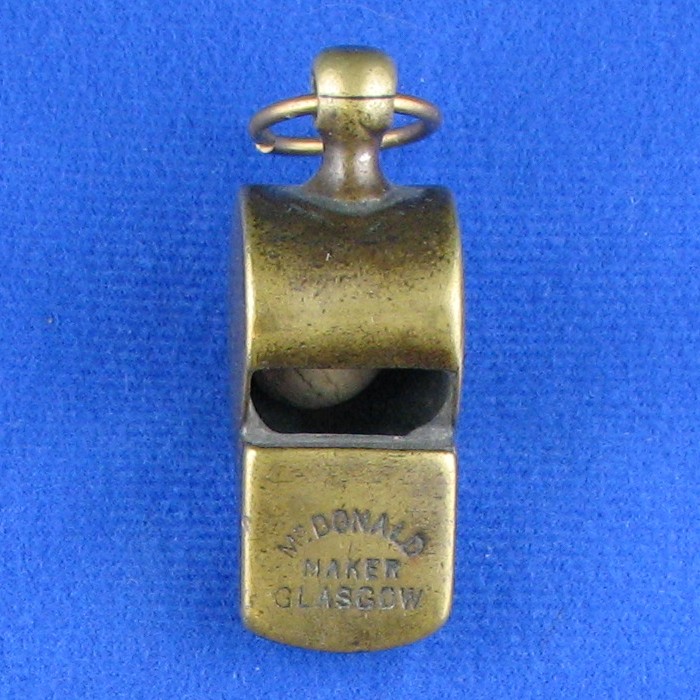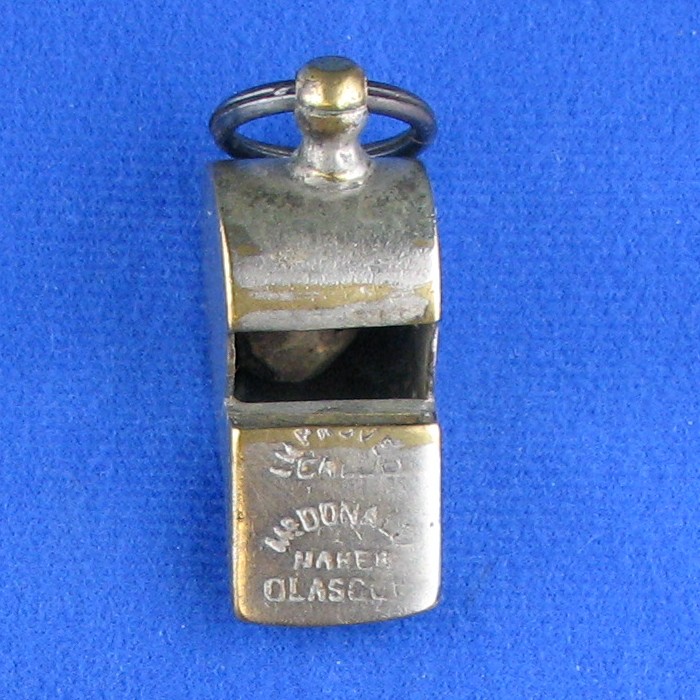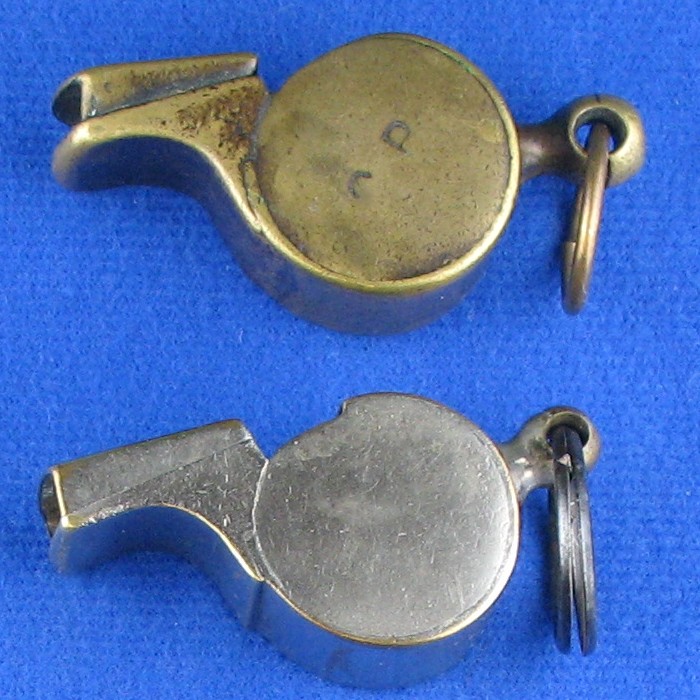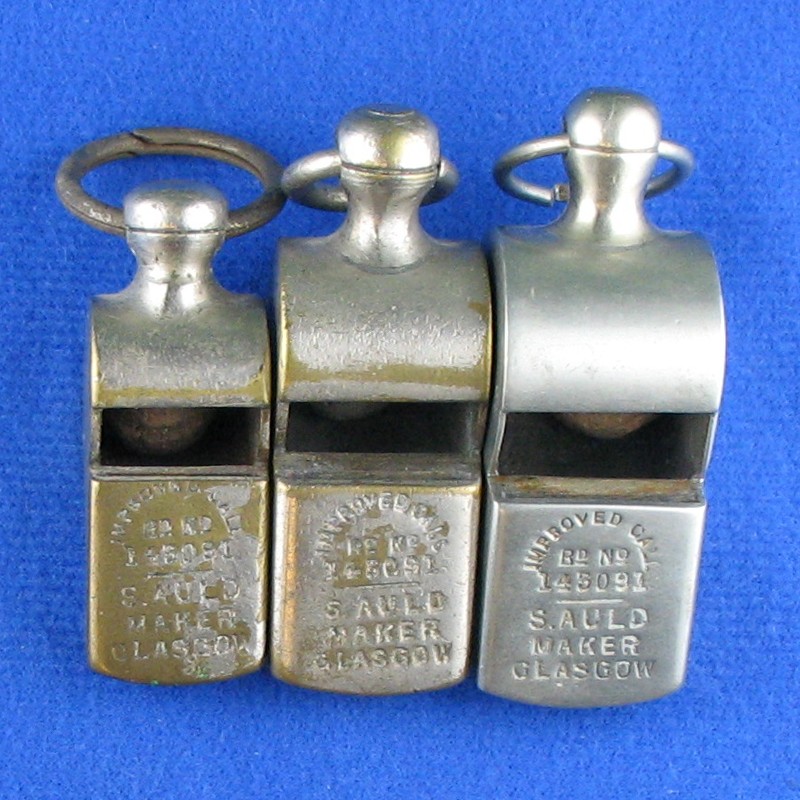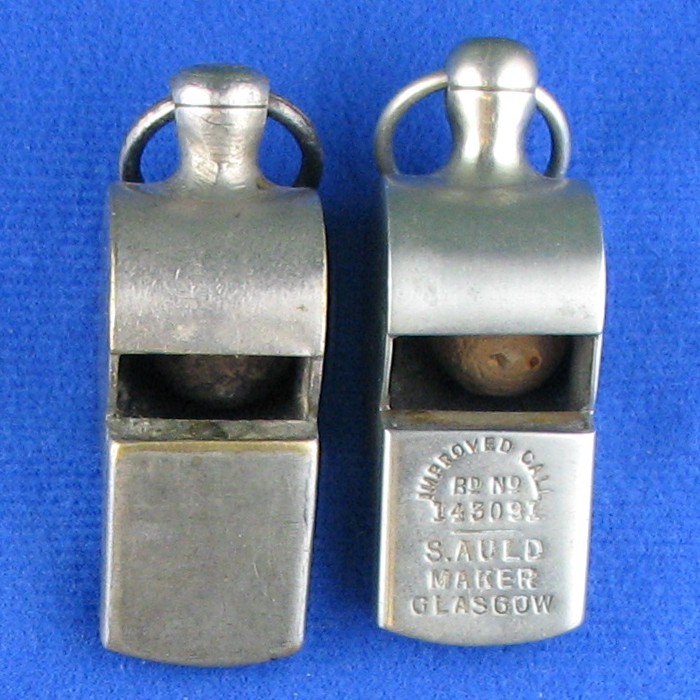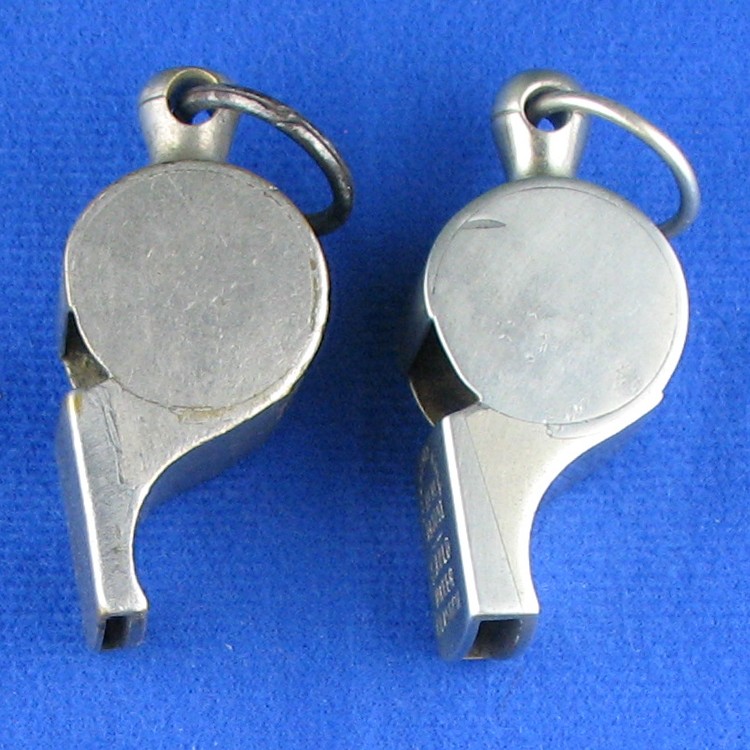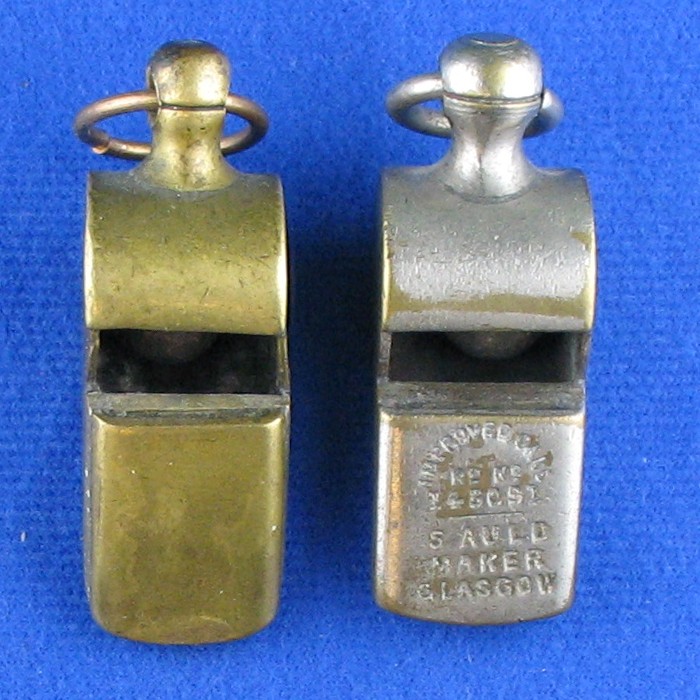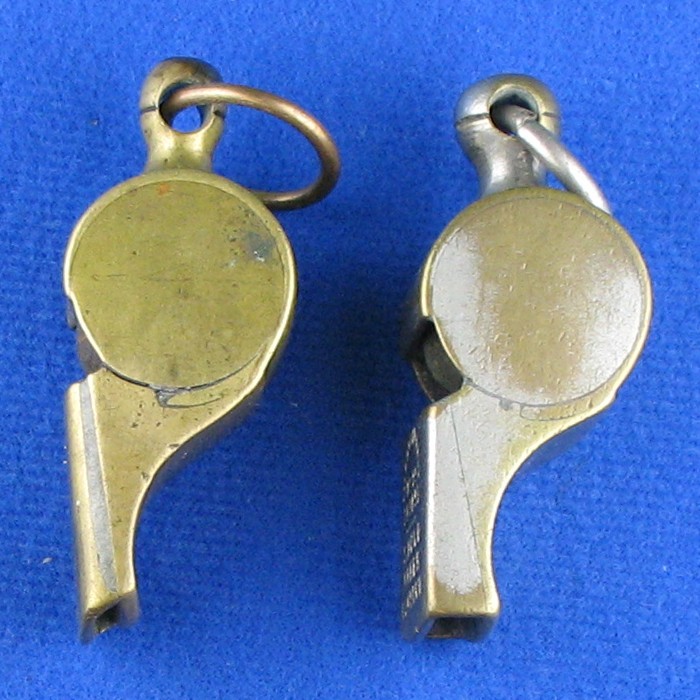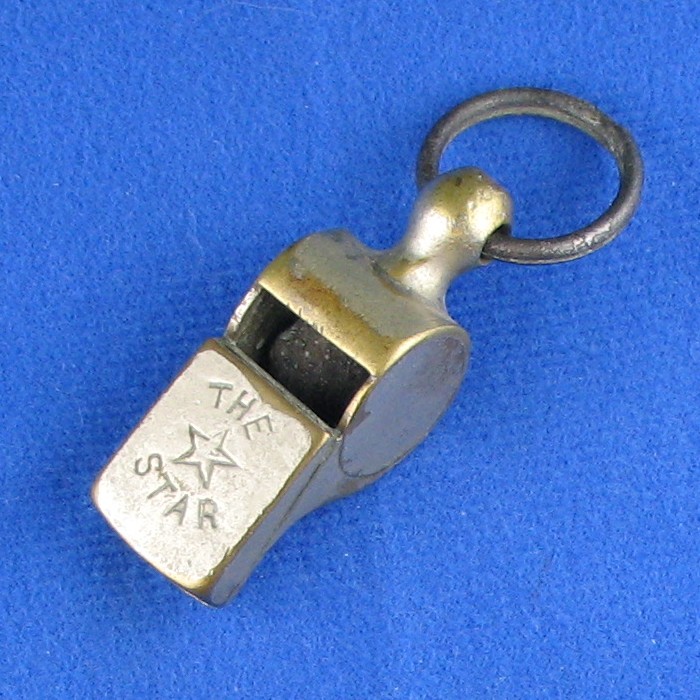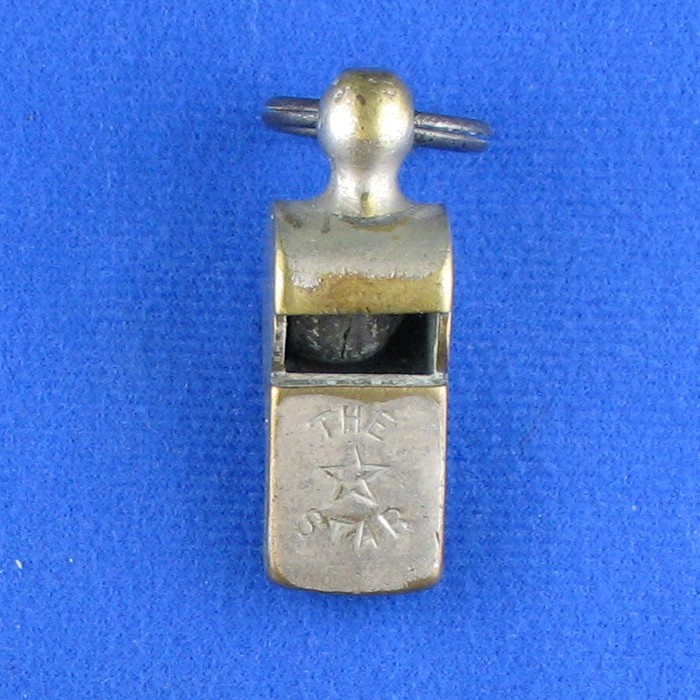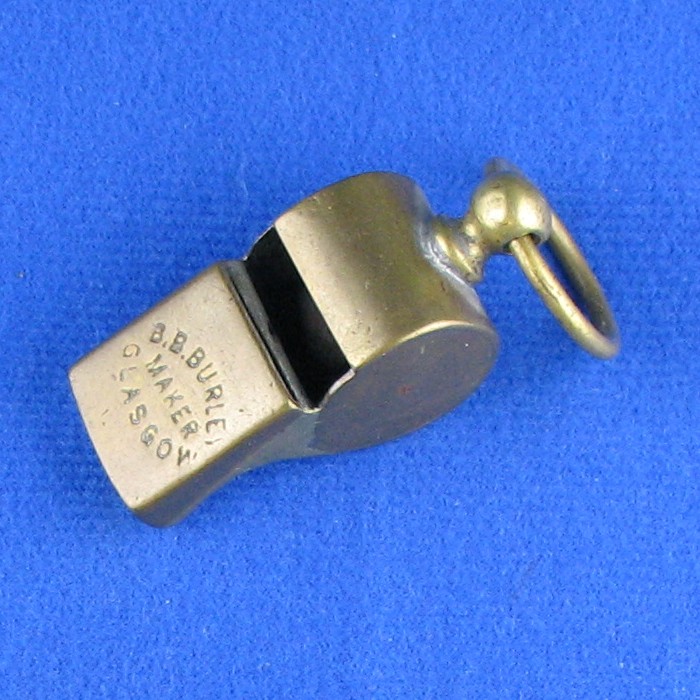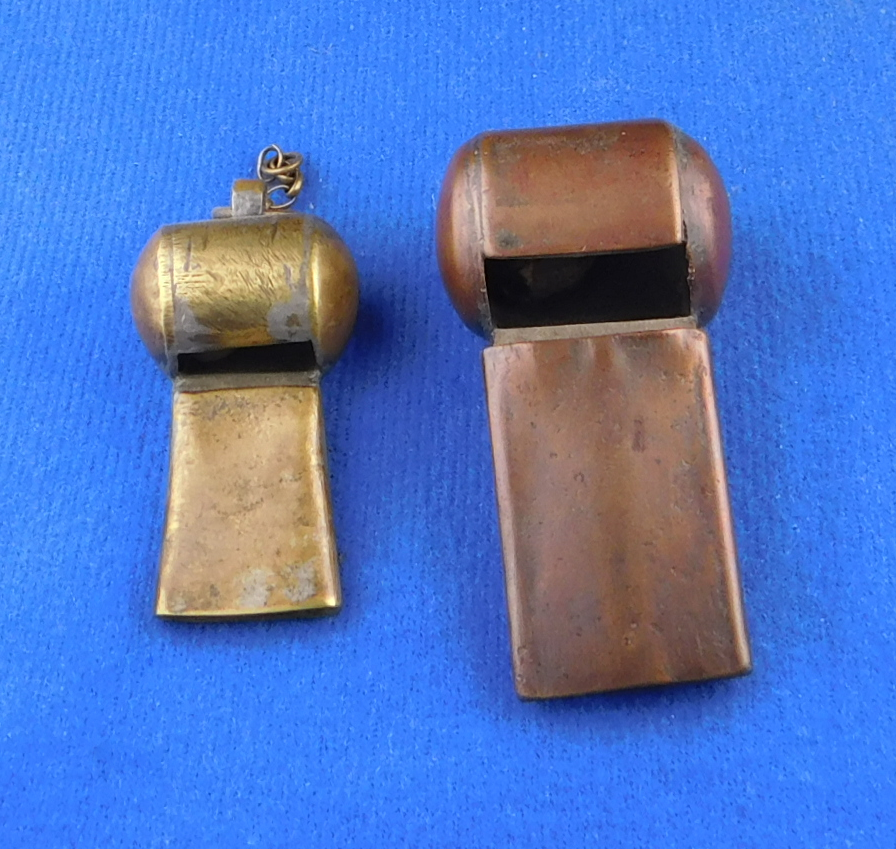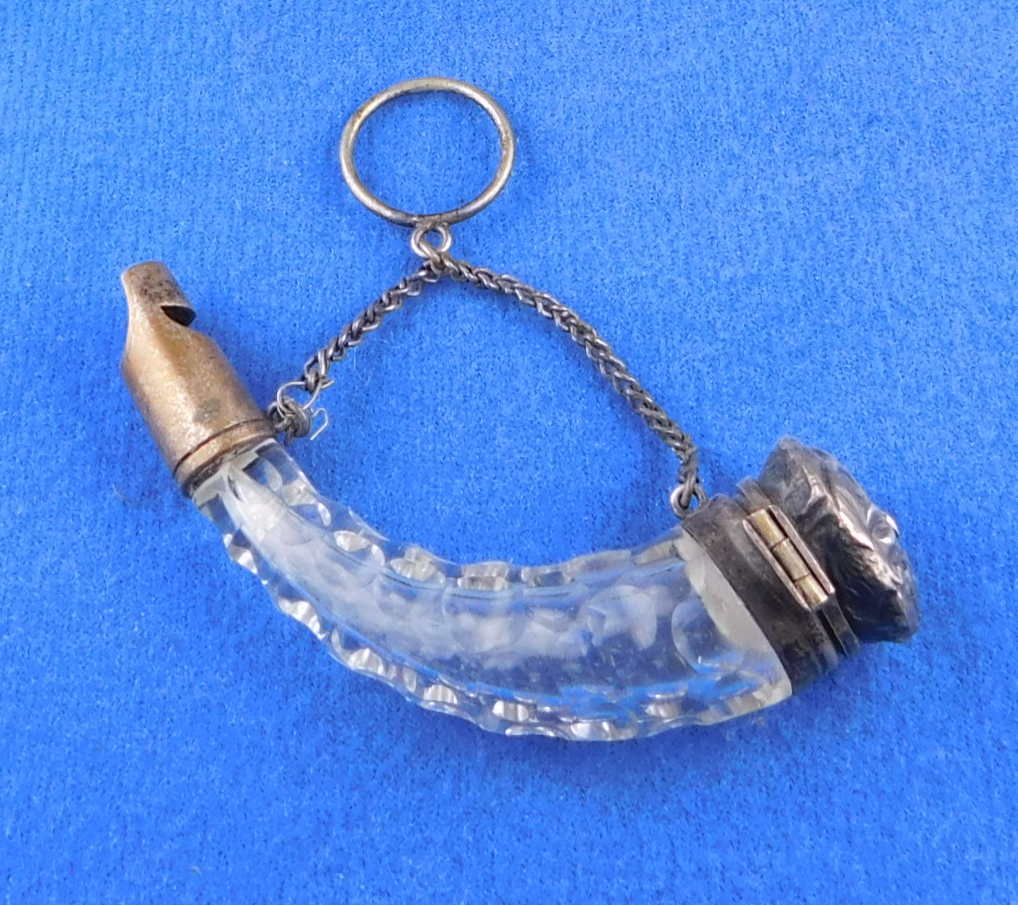Spotlight > Whistle Categories > Escargot > 091
WHISTORY:
On page ten of More Whistles ( Martin Gilchrist 2005 ) says that ‘Samuel Auld designed the Glasgow escargot, a very robust whistle, made in three sizes using six components’ which came from Scotland’. — Whether this holds true as to the designer, we will discuss further. Most metal escargots seen today are made from three pieces of pressed or stamped metal, the top piece that folds over each side, the under barrel and the knop and this stems from the 1891 patent by Hudson ( UK ). Older ones were five pieces ( classics, some down through the century and still some newer ones made today ), the added pieces is by counting two more separate sides instead of a single plate folding over the two sides. And then there are four piece escargots made like button whistles with under strengthening below the mouthpiece which were from the 1880s. Button whistles themselves appear to be the earliest escargots following a ‘London’ type construction and usually made four to five ‘ish’ pieces. So it can get a little confusing.
Conclusively and for our discussion, the ‘six piece’ escargot has a special aspect, ALL six pieces are cast and then assembled. Unique in whistle history, this was labor intensive, the overall whistle being very heavy. They have been found in many graduated sizes ( beyond three as earlier described ), mostly due to the handmade qualities — but are predominantly found in three sizes. Centered in Great Britain very few makers made them and during what appears to be within mere 15 year period, circa 1878 to 1891 which makes them scarce to very rare. None have been found from any other countries.
These dates are fluid and based on the first advertisement flyer by Henry Arthur Ward of 1879 and the possible demise of six piece manufacturing probably coinciding with Hudson’s 1891 three piece escargot patent. To produce a full page ( SEE SPOTLIGHT 83 ) offering three different sizes of escargots ( models 23, 24, 25 ) Ward would have had to been manufacturing them already, so this dates them at a minimum of 1878, likely earlier. Indeed there are already eleven whistles being manufactured.
Curiously, the Auld escargot with the stamped registered design number ( 143091 ) for 1890 is found commonly, leading to the conclusion that there were quite a few made post 1890. However it seems counterproductive to think that such a labor intensive whistle would be pitted against the many cheaper and easier to make escargots, simultaneously by Auld’s competitors. No known six piece escargot has been found by Hudson.
The bulk of six piece escargots seen today are admittedly stamped Auld. At the same time Improved, implying there were ones originally made before improvements, yet it could well have been a marketing method. However McDonald did produce whistles stamped with and without ‘improved’ on them. No Auld six piece whistles have been found with Auld stamped on them, but without ‘Improved’ ( nor the registration number ). There are six piece escargots which are known without any stamp at all which, could possibly have been made by Auld.
Three manufacturers ( i.e. McDonald, Auld and Ward ) used the stamp Improved on their whistles. It is not known for a certainty that Peter McDonald made whistles. It is assumed so because he filed for a patent with Ward. However Ward had already been making the patent design for a decade. Indeed the Very whistle model 25 by Ward has the Ward/McDonald patent number stamp ( 2980 ) on it. Admittedly, close examination of McDonald against Ward and Auld show that the top plate is shorter for McDonald and thereby the under-strengthening is correspondingly shorter signifying a different manufacturing process.
Apparently Auld’s earliest whistles during this period ( 1878 to 1891 were round whistles marketed as ‘police calls’. However it was Ward that first advertised the six piece in 1879 and we now look to him as the likely designer of the Glasgow escargot instead of Auld. Ironically considering the much earlier start, very few Ward whistles have survived with model numbers and even less with his stamp H.A.W. on them verifying the manufacturer.
Consequently three different known manufacturers emerge during this time frame — two from Glasgow, one from Birmingham.
- Henry Arthur Ward ( Birmingham )
- Samuel Auld ( Glasgow )
- Peter McDonald ( Glasgow )
H.A.W is found back stamped on a model #25 — the smallest of the three advertised, also BM for Birmingham and patent with Pl for provisional. This equates to announcing that a patent has been applied for. This may be true or ‘intended’. There are whistles stamped with ‘patent’ that no patent is recorded for. So, did Ward make this model ( the model 25 was unknown when Gilchrist published More Whistles ) as early as 1878 and intend to patent it, but did not for ten years ?? Or is it merely a later model 25 ??
Many questions arise for this period. Another whistle, stamped The Very Whistle No. 23 has a back stamp Patent # 2980 which was filed by Henry Arthur Ward jointly with Peter McDonald for Feb 25th 1890 ( later abandoned, since Auld filed for a registered design less than a month prior — registered designs were much less expensive to obtain than patents). Why would Ward do this since he had been making this whistle for ten years already ?? McDonald is also known for manufacturing whistles according to the 2980 patent, yet they were slightly different construction. Why are so few known to exist ?? This whistle is very similar to the Auld largest size escargot.
At the same time, very few other unknown manufacturers ( or none ) of six piece escargots have been found. Of the few we have here at the reference collection we will try to establish a tentative timeline. The article is editable and with uncovered information we can update it for the world wide data base.
Questions for research are:
- How far back do 6 piece whistles date before 1878 ??
- How many manufacturers made them ??
- How did they get their training ??
- Did any work for the other manufacturer to learn the process ??
- What were the improvements claimed ??
- When did Auld start making escargots ??
- Are whistles for Auld with Registered Design numbers 1890 and later ??
- How early were Auld 6 piece whistles made from and when did they stop ??
- How did Ward and McDonald get together ??
Jan. 29, 1890 — Auld registered design number143091/1890
Feb 25, 1890 — Ward/McDonald patent # 2980 Pl (provisional) –
The following is to try to lay out a timeline. Some things could be totally wrong and need correction or simple adjustments. However it is important to track them as they unfold into deeper study.
WHISTLE ARCHEOLOGY:
Henry Arthur Ward whistles are difficult to obtain for examination. Here are two sizes. Model 23, the smallest and model 25 the largest. Additionally the model 25 is stamped the Very Whistle – it has the patent number 2980 on the back, whereas model 25 has HAW.
If we can obtain model 24 we will include it, but the competition is difficult.
Ward sets the standard for all other six piece whistles.
Next we look at McDonald pre ‘improved’ patent 2980. We note that not on either pre or post improved is the patent stamped on his whistles as Ward did. We also do not know when McDonald started and ended making whistles.
Are we to find any ?? Or is it possible that Ward made McDonald’s whistles ?? Why then would Peter McDonald be included in the patent application ??
Lastly, Auld’s registered design. How long his six piece whistle was made before the registration date of 1890 is unknown. However they are always stamped ‘improved’ whistles, suggesting earlier production.
Presented here are two unstamped and unmarked six piece escargots, perhaps earlier efforts.
Mid size model ( left ) very closely matches )
Unlike the midsized model above, small size below, left is actually different than the ‘improved’. Another six piece whistle was seen recently that matching the unstamped ( left ) model, clearly showing where improvements could be made and that it was a production whistle.
Note the connections to the side walls. The smoother rounded edges and the mouth is rounded more.
Most improvements were made in the top plate
A very early six piece whistle – THE STAR is recorded here.
Whether the STAR was an early model Ward is unknown. However it does follow the same construction methods albeit the knop is larger and out of proportion.
To be yet another manufacturer is very unlikely, yet it is as of yet, unassigned.
Lastly we visit B.B. Burley MAKER, although stamped Maker, this would not indicate he was the manufacturer.
Conclusions are still difficult with six piece escargots. It has proved to be a very unusual period of whistle making in the UK and we hope to find more revealing examples.
As always observations are invited as well as pictures of other six piece examples and notation or corrections are appreciated.
– TWG
Posted August 5, 2018
